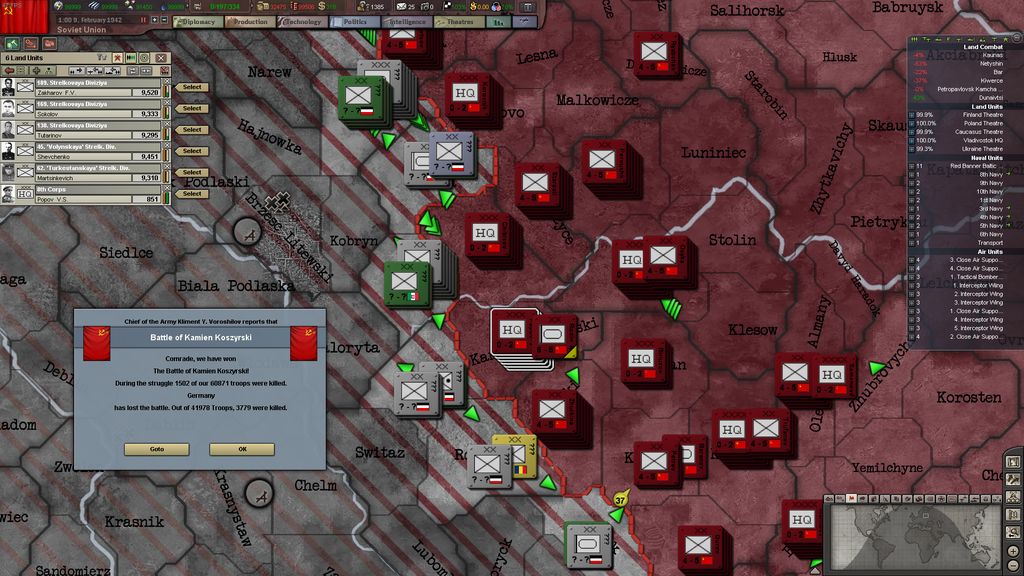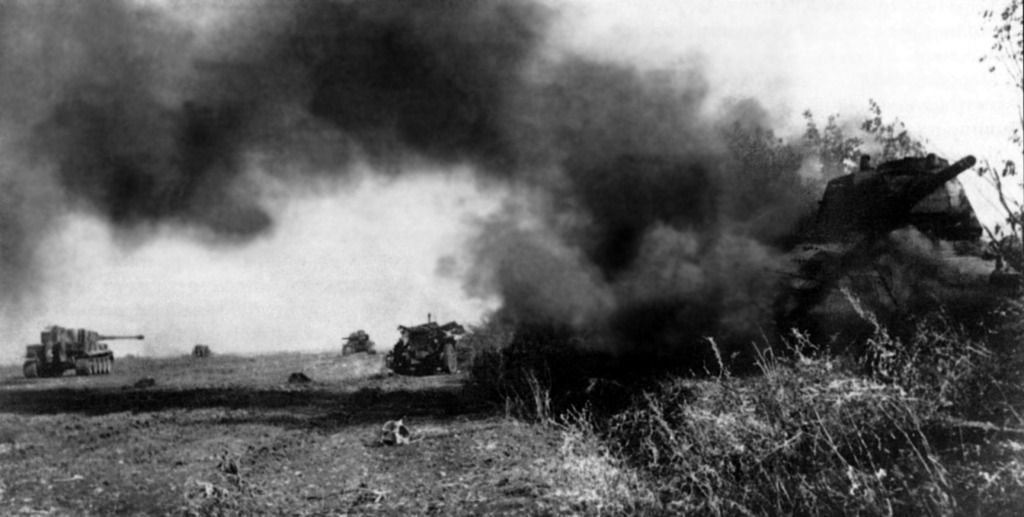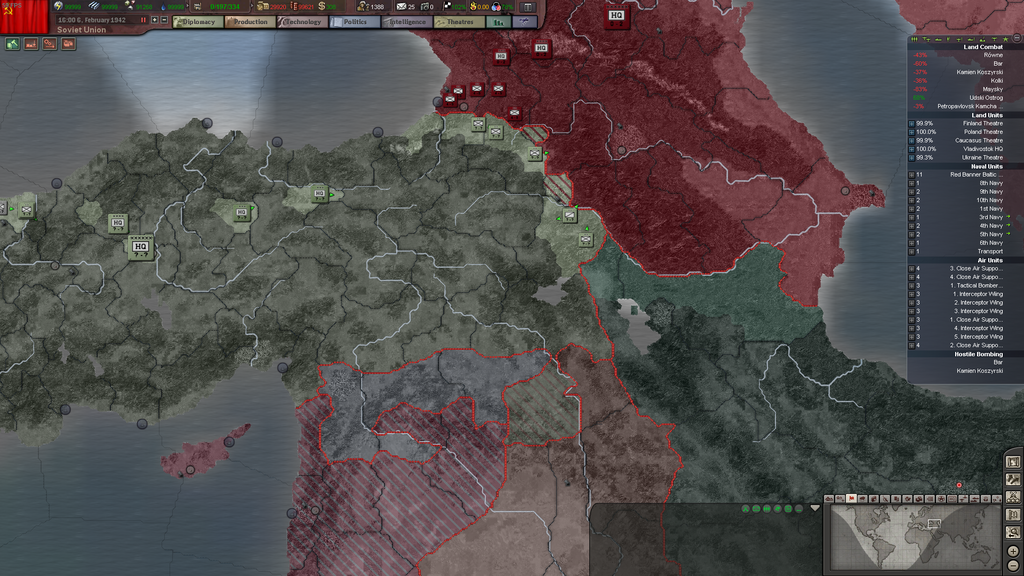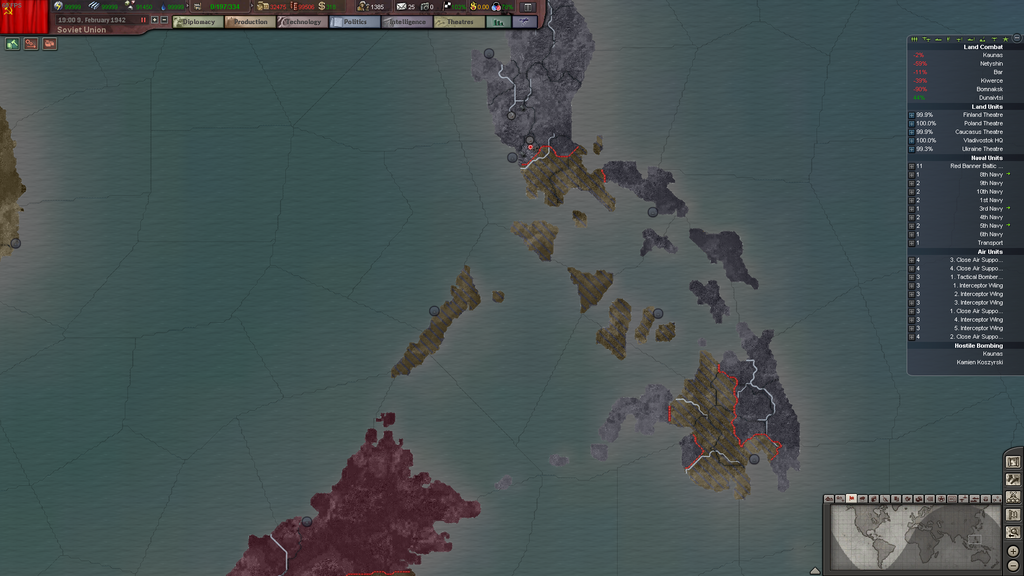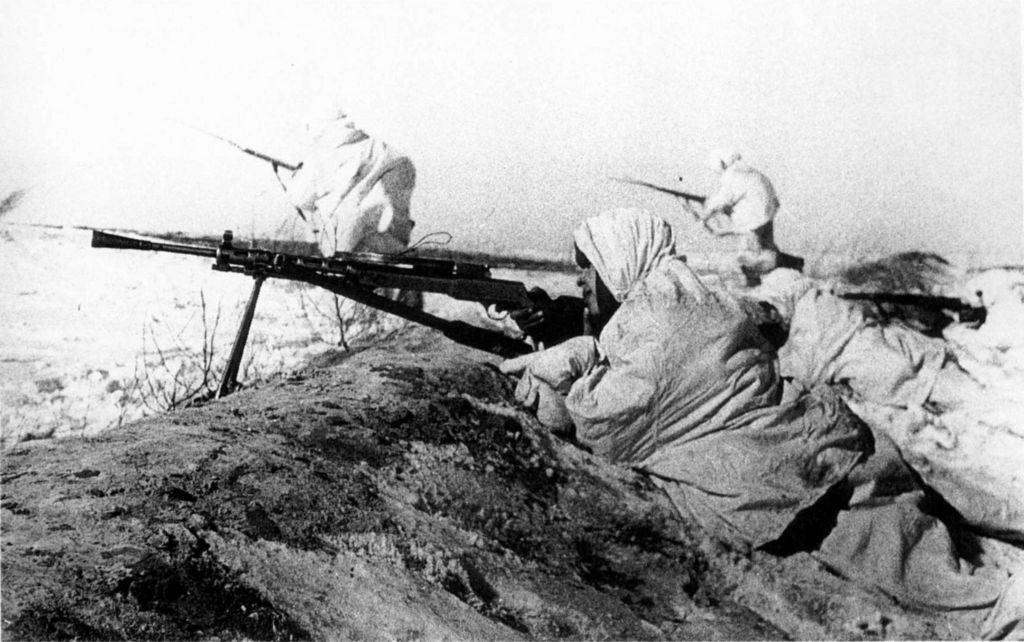Invincible and Legendary
The History of the Soviet Union during the Great Patriottic War
February 1942 part 1
The first days of February were a period of remarkable calm as both the Soviet Union and the Axis adjust themselves to the new strategic situation. Turkey had joined the Axis and cut the Black Sea off from the Mediterranean. German divisions continue their offensives and also move to reinforce the new Caucasus Front. In retaliation, the Soviet Union prepared its first real counterattack on the Polish Front. Fighting flared up once again in the second week across all theatres.
Home Front
After the fall of Vladiwostok to the Imperial Japanese army in mid-November, the US lend-lease convoys were rerouted through the Mediterranean and Black Sea, delivering their cargo to the port of Sevastopol. With icebergs blocking the Northern Ice Sea and German control of the Denmark Straits, the Mediterranean-Black Sea Route was the only available option for bringing supplies and materiél into the Soviet Union. Valuable assistance from the United States arriving via this route provided an important boost to Soviet military production. Through various international treaties from the 18th century onwards it was agreed that Turkey would keep the Straits open to all sides in case of a war she was not involved in, as long as the ships passing were not armed with guns of a caliber greater than 203mm.
The Turkish Straits
A map of the Turkish Straits. Notice especially the extremely narrow Bosporus
A treaty signed in 1936 guaranteed free passage for all nations bordering the Black Sea during peace time. In case of war or threat of war, Turkey was allowed to close the straits to her enemies. To this end she was once again allowed to fortify the Dardanelles, something that was forbidden after the Great War. Non-Black Sea warships larger than 15.000 tons were banned from entering the straits. Smaller warships were limited to a maximum of 9 ships, a total tonnage of less than 30.000 tons and a maximum stay in the Black Sea of 21 days.
Since the 19th century, Turkish coastal defences around the straits have been equipped with heavy artillery up to 305mm in caliber, mostly German heavy guns produced by Krupp. With these heavy guns, Turkey could prevent any ship from entering the straits and threathen the capital.
As the Turks entered into an alliance with the Axis, this means that both Soviet overseas trade convoys and the US lend-lease convoys to the Soviet Union are being blocked at the Dardanelles. For the second time this war, the lend-lease convoys have been cut off from reaching their destination. Once again the convoys are cancelled and Allied High Command looks for a new way to get supplies through to the Soviet Union. For now this proves to be impossible, since Germany blocks the Baltic Sea route by occupying the Denmark Straits and poor weather prevents convoys from taking the northern route to Murmansk or Archangelsk. Vladiwostok has fallen and no other ports in the Far East are available, and now the Black Sea has been cut off at Istanbul.
Baltic Front
A new month and a new Italian offensive to take Kaunas has begun. Once again the Regia Esceterio throws some 37.000 men into a frontal attack against the fortress city manned by Soviet infantry and Red Guard divisions and the result is even worse than last month. 2400 Italian infantrymen are mown down in the fields before the city by concentrated heavy artillery and machinegun fire in a Great War-style massacre. Casualties on the defending side are less than 10% of that, mostly due to German air strikes.
Polish Front
The Hungarian army launched the first attack of February on the Polish front against the defences of Rozana. Though both sides fielded some 50.000 men in the fight, the Hungarian light infantry was no match for the Soviet infantry corps with heavy artillery support and 2 armoured divisions and took heavy losses during the attack. Some 270 Soviet and 1700 Hungarian troops fell in the one-sided battle.
The next major German attack on the sector around Kamien Koszyrski is launched in early February as well. As part of this attack, several other positions come under heavy attack. The Germans launch another attack on Rowné, which is fought off with heavy losses on both sides in the evening of the 7th of February. Some 1900 casualties on either side are suffered, but Soviet lines hold firm. 50 kilometers to the north, an Italian assault on Kolki leaves 1100 Soviet and 1800 Italian dead on the flank of Kamien Koszyrski as the real battle rages in the streets of the city between Soviet and German infantry. 2 days after the Italian withdrawal, this fierce battle finally ends when the Germans break contact and withdraw from the city. A scene of utter carnage is left behind in the western suburbs of the city, where the Germans ran into successive belts of Soviet defences, designed to wear the enemy down and destroy them piecemeal.
The Germans and Hungarians return 3 days later with fresh infantry and motorised divisions. The Soviet defenders are being worn down in the grinding bloodbath around the city, but still the defences hold. It appears the German units have been withdrawn rather quickly, leaving the brunt of the assault to the lightly armed Hungarians. Although the Soviet 8th corps is all but exhausted after another 3 days of fighting, they have only suffered 130 casualties to the Hungarians 1500.
50 kilometers south of here the Germans slam into the defences on the dividing line between the Polish and Ukranian Fronts with masses of armour. Multiple divisions of heavy armour backed by masses of infantry tear through the Soviet infantry in Netyshin. Even the support of a division of T-34 tanks couldn't make a difference as the Germans blast their way through successive strongpoints using their Tiger heavy tanks. 900 Germans and 2200 Soviets are killed as German heavy tanks crush the defences one after another and force the Soviet divisions to withdraw.
Burned out Soviet tanks on the fields of Netyshin as German heavy armour breaks through the defences
On the edge between the Polish and Ukranian Fronts, the Red Army strikes against a combined Romanian-Slovakian force entrenched in Dunaivtsi. Outnumbered 3:1 by the axis infantry, superior Soviet artillery break the enemy morale and throws the Axis troops back in disarray with some 1300 casualties on either side. Further north however, the simultanious attack against Polonne by the tanks of the 82nd Motorised Division and 3 infantry divisions fails to break through the tougher German defences. This attack was mostly designed to threathen the flank of an advancing German heavy tank division, which is now pushing northeast into Netyshin. The Soviet lines attempt to stick together and only pull back in an organised fashion when neccesary and sometimes these attacks are needed to maintain that line.
Ukranian Front
The Romanian army had crossed the Dniester in force in early February, supported by a number of German and Italian divisions. Attacks against Soviet positions in Kotovsk, some 100 kilometers north of Odessa continue, but Soviet infantry have entrenched once again. Although the new defensive line is not screened by a river, the Soviet infantry holds the line reasonably well for the moment.
On the northern side of the front, elements of the Soviet 12th and 28th Corps came under heavy attack at the town of Bar. thanks in no small part to the chaos and confusion that reigned in the area following the recent withdrawal, which had left these 2 corps mixed together on a small sector of front, heavy losses are sustained when the Germans attack the columns of retreating troops. As 20th Corps tries to make a stand and 28th Corps tries to pull back, German heavy artillery causes hundreds of casualties before the defenders can get organised. Once the defenders are in place by February 9th they manage to halt the German attack and cause severe losses to the enemy, but by that time the damage has already been done.
Caucasus Front
RADAR installations and listening posts in the naval base at Sevastopol report the first German and Hungarian mountain forces crossing the Bosporus. The Caucasus Front will have to be brought up to strenght before these armies can reinforce the Turkish army and launch a full scale invasion.
Indeed, the first Turkish divisions have begun crossing the border on the eastern side. The first Soviet infantry divisions that were rushed to the sector instead of being send to the Far East have drawn up a line anchored on the Black Sea, but they cannot cover both the northern and eastern axis of advance. Other Turkish units are already invading Iraq and probably reinforcing Syria, where the British Army of Egypt has almost reached the Turkish border.
Far Eastern Front
The counterattack by the 5th army in the northeast of the Far Eastern Front continues to push the Japanese infantry and marines back towards Manchuria. The corridor on the coastline is only a few kilometers wide and as the forward echelons press towards the surrounded troops on the coast, the second wave of infantry attempts to broaden the breakthrough and prevent the corridor from collapsing.
It is obvious that this relief attempt must succeed now, or it will be too late for a large chunk of the Far Eastern Front under siege on the coast north of Vladiwostok. The encircled troops are running low on ammunition and are getting more and more disorganised. The combined Japanese breakthrough in northern Manchuria and from Sakhalin to the mainland has completely outmaneuvered the Red Army here and if no reinforcements can arrive, they will be forced to surrender soon.
On the other side of the front, Soviet infantry is slowly but steadily halting the Japanese advance deeper into Siberia. Whilst this is good news, there are not enough divisions available to hold a coherent line, let alone organise a strong enough counterattack to support the eastern flank under siege.
Foreign Affairs
The war in the Pacific continues in early February with the Japanese once again seizing Guam. The Americans strike back at roughly the same time however and seize the nearby Japanese island of Saipan. It is clear both sides want to remain on the offensive and seize islands and naval losses must be mounting.
In the Dutch East Indies, the Japanese have begun an invasion of Java by capturing a port on the eastern side of the island. The Japanese invasion of the Phillipines is still ongoing and heavy fighting rages around the capital Manila and on the southern island.
By contrast, Japanese forces in Siam are not making much progress beyond the initial border regions in Malaya and Burma. British, Nepalese and Bhutanese divisions have erected decent defences in the jungles here and neither side seems capable of breaking through at this time.
Operation Mars
With the German offensive mostly brought to a halt but the Caucasus and Far Eastern Fronts still more or less in retreat, Soviet High Command feels the time has come to attempt a counterattack against the Axis on the main front. A relatively small scale offensive will be prepared with the aim of eliminating a sizable concentration of mostly German divisions through encirclement. The rather simple battleplan, codenamed Operation Mars, has been depicted on the map below.
The army assembled for the operation is an ad hoc battlegroup consisting mostly of motorised and armoured divisions from 3 different mechanised corps and some Red Guard shocktroops. Their objective is to break through directly north and south of the concentration of Axis divisions and link up in Kobryn, just east of Brest-Litovsk. Some infantry corps are brought up to act as a second wave and to help in covering the flanks and pinning down the enemy. All in all, the Red Army has assembled several hundred thousand men in the area, earmarked for the first major counterattack of the war.
Soviet infantry prepare to go into action as Operation Mars kicks off




